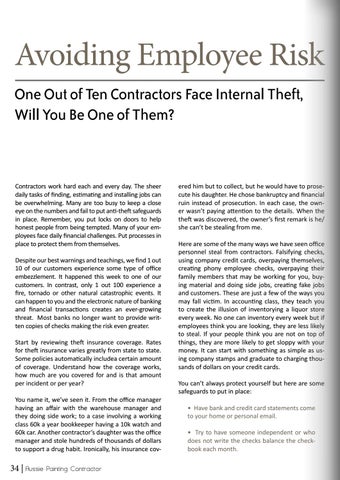Avoiding Employee Risk One Out of Ten Contractors Face Internal Theft, Will You Be One of Them?
Contractors work hard each and every day. The sheer daily tasks of finding, estimating and installing jobs can be overwhelming. Many are too busy to keep a close eye on the numbers and fail to put anti-theft safeguards in place. Remember, you put locks on doors to help honest people from being tempted. Many of your employees face daily financial challenges. Put processes in place to protect them from themselves. Despite our best warnings and teachings, we find 1 out 10 of our customers experience some type of office embezzlement. It happened this week to one of our customers. In contrast, only 1 out 100 experience a fire, tornado or other natural catastrophic events. It can happen to you and the electronic nature of banking and financial transactions creates an ever-growing threat. Most banks no longer want to provide written copies of checks making the risk even greater. Start by reviewing theft insurance coverage. Rates for theft insurance varies greatly from state to state. Some policies automatically includea certain amount of coverage. Understand how the coverage works, how much are you covered for and is that amount per incident or per year? You name it, we’ve seen it. From the office manager having an affair with the warehouse manager and they doing side work; to a case involving a working class 60k a year bookkeeper having a 10k watch and 60k car. Another contractor’s daughter was the office manager and stole hundreds of thousands of dollars to support a drug habit. Ironically, his insurance cov-
34 | Aussie Painting Contractor
ered him but to collect, but he would have to prosecute his daughter. He chose bankruptcy and financial ruin instead of prosecution. In each case, the owner wasn’t paying attention to the details. When the theft was discovered, the owner’s first remark is he/ she can’t be stealing from me. Here are some of the many ways we have seen office personnel steal from contractors. Falsifying checks, using company credit cards, overpaying themselves, creating phony employee checks, overpaying their family members that may be working for you, buying material and doing side jobs, creating fake jobs and customers. These are just a few of the ways you may fall victim. In accounting class, they teach you to create the illusion of inventorying a liquor store every week. No one can inventory every week but if employees think you are looking, they are less likely to steal. If your people think you are not on top of things, they are more likely to get sloppy with your money. It can start with something as simple as using company stamps and graduate to charging thousands of dollars on your credit cards. You can’t always protect yourself but here are some safeguards to put in place: • Have bank and credit card statements come to your home or personal email. • Try to have someone independent or who does not write the checks balance the checkbook each month.












